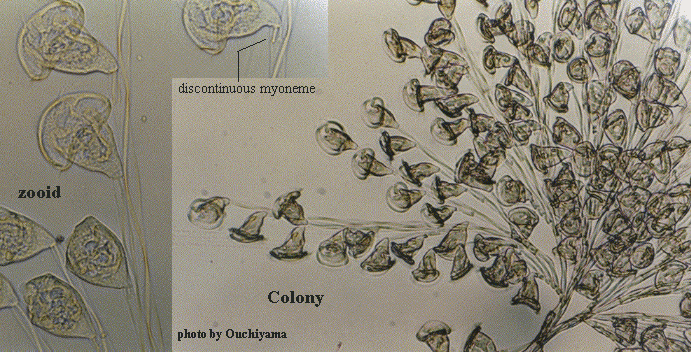Carchesium
Carchesium Ehrenberg, 1830 (ref. ID; 2014)
Family Vorticellidae Kent (ref. ID; 1248) [ref. ID; 2014]
Colonial. Inverted bell-shaped zooids borne upon the ends of a branched stalk which contracts in a spiral fashion. Contraction of the stalk is by means of a discontinuous myoneme, which can cause the side branches of the colony to contract independently of each other. Peristome with lip as in Epistylis. Carchesium was first described by Ehrenberg (1830) and the genus is most easily mistaken for the other contractile colonial peritrichs Pseudocarchesium and Zoothamnium. However, in both of these genera the stalks contract in a zigzag fashion, not spirally. In Pseudocarchesium the myoneme is also discontinuous but in Zoothamnium the myoneme is continuous throughout the colony.
Quote; Colin R. Curds, Michael A. Gates and David McL. Roberts "British and other freshwater ciliated protozoa Part II Ciliophora: Oligohymenophora and Polyhymenophora" Cambridge University Press, 1983 (ref. ID; 2014)
- Carchesium aselli Engelmann, 1862 (ref. ID; 1620)
See; Pseudocarchesium aselli (ref. ID; 1248) - Carchesium brevistylum Stiller, 1931 (ref. ID; 1620)
- Carchesium corymbosum Penard, 1922
See; Carchesium polypinum (ref. ID; 4610) - Carchesium ephemera Soramek-Husek, 1948 (ref. ID; 1114)
See; Pseudocarchesium erlangensis Nenninger, 1948 (ref. ID; 1114) - Carchesium epistylis Claparede & Lachmann, 1850 (ref. ID; 1620)
- Carchesium erlangensis Nenninger, 1948 (ref. ID; 1114)
See; Pseudocarchesium erlangensis Nenninger, 1948 (ref. ID; 1114, 1248) - Carchesium gammari
See; Pseudocarchesium gammari (Precht, 1935) (ref. ID; 1248) - Carchesium gemellum O.F. Muller, 1786(?) (ref. ID; 1620)
- Carchesium globosum Kusters, 1974 (ref. ID; 4654 original paper)
- Carchesium granulatum Kellicott, 1887 (ref. ID; 1620) reported year? (ref. ID; 1618)
- Carchesium inconjunctum
See; Pseudocarchesium inconjunctum (Korfsmeier, 1948) (ref. ID; 1248) - Carchesium limneticum Svec (ref. ID; 1335)
- Carchesium oectinatum (Zacharias, 1897)
Syn; Zoothamnium limneticum Svec, 1897 (ref. ID; 1620) - Carchesium pectinatum (Zacharias, 1897) (ref. ID; 492, 1620, 1629) or (Zacharias, 1897) Kahl, 1935 (ref. ID; 4488, 4610)
Syn; Zoothamnium limneticum Svec, 1897 (ref. ID; 4610); Zoothamnium pectinatum Zacharias, 1897 (ref. ID; 4610) - Carchesium picta Ehrenberg, 1831
See; Vorticella picta (ref. ID; 4610) - Carchesium polypinum Linnaeus, 1758 (ref. ID; 1219, 1557, 1620, 1896, 2245, 2573, 3292) reported year? (ref. ID; 1618), Linne (ref. ID; 3343, 5462) or (Linnaeus, 1758) Ehrenberg, 1830 (ref. ID; 4610) reported author and year? (ref. ID; 191, 3113, 7114)
Syn; Carchesium corymbosum Penard, 1922 (ref. ID; 4610); Sertularia polypina Linnaeus, 1758 (ref. ID; 4610) - Carchesium polypinum f. corymbosum Penard, 1922 (ref. ID; 1248)
- Carchesium pygmaeum Ehrenberg, 1838
See; Epistylis pygmaeum (ref. ID; 4613) - Carchesium pygmeum D'Udekem, 1864
See; Zoothamnium asellicola (ref. ID; 4730) - Carchesium spectabile Ehrenberg-Claparede & Lachmann, 1858 (ref. ID; 1620)
Syn; Carchesium lachmanni Kent, 1881 (ref. ID; 1620) - Carchesium spectabile Kent, 1881 (ref. ID; 1620)
- Carchesium steini
See; Pseudocarchesium steini (Precht, 1935) (ref. ID; 1248) - Carchesium variabilie Kusters, 1974 (ref. ID; 4654 original paper)
Carchesium granulatum Kellicott, 1887 (ref. ID; 1620) reported year? (ref. ID; 1618)
Descriptions
Two contractile vacuoles anterior; on Cambarus and aquatic plants. (ref. ID; 1618)Measurements
About 100 um long. (ref. ID; 1618)Carchesium polypinum Linnaeus, 1758 (ref. ID; 1219, 1557, 1620, 1896, 2245, 2573, 3292) reported year? (ref. ID; 1618), Linne (ref. ID; 3343, 5462) or (Linnaeus, 1758) Ehrenberg, 1830 (ref. ID; 4610) reported author and year? (ref. ID; 191, 3113, 7114)
Synonym
Carchesium corymbosum Penard, 1922 (ref. ID; 4610); Sertularia polypina Linnaeus, 1758 (ref. ID; 4610)Descriptions
Body bell-shaped, very often more or less bent; peristome outwardly extended; 1 long band-like macronucleus extends along the longitudinal axis of the cell; 1 contractile vacuole near the buccal cavity; sessile; colonial; young solitary individuals of C. polypinum resemble mature stages of the non-colonial Vorticella convallaria, which may occur in the same habitats. (ref. ID; 1219) [ref. ID; 3113]Measurements
Individuals 80-140 um, colonies up to 3 mm; main stalk up to 1 mm long and 20 um in diameter. (ref. ID; 1219)100-125 um long. (ref. ID; 1618)
Length of cells 60 um. (ref. ID; 3343)